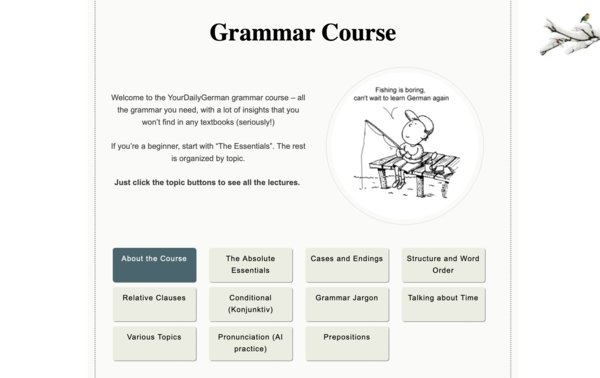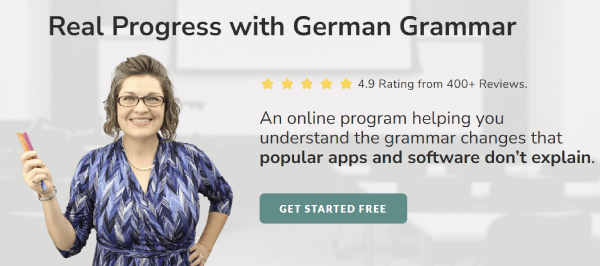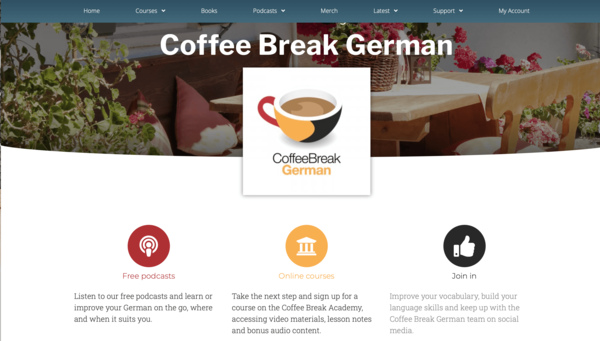10 Must-Read Blogs for Learning German
Are you eager to start learning German but don’t know where to start? The internet has revolutionized learning, making it incredibly convenient and easy to learn new skills, such as foreign languages. If you’re interested in learning German but don’t have access to a traditional classroom setting, turning to the right blog for learning German could be your ideal solution.
But which is the best blog for learning German? Well, different blogs have different ways of teaching. Some make learning fun with information about German culture, while others have step-by-step German lessons from a beginner to advanced German level.
Some German blogs have videos to help you learn, while others have useful graphs and images to help you understand German grammar more easily! Depending on what your learning style is, there’s an app for you!
In this article, we’ll look at 10 must-read blogs for learning German to make learning enjoyable and feel effortless for English speakers. Are you ready? Let’s go!
1. lingoni

If you’re looking for a blog to help you learn German, (or English or French for that matter!) lingoni is the language blog for you!
lingoni is a women-owned language company that teaches German with an all-around approach, offering everything from video lessons and podcasts to specialized vocabulary training and a pronunciation tool.
The lingoni blog has got you covered with additional learning resources, whether you’re learning about German prepositions, German grammar rules, German verbs, or even cultural subjects.
As a paid member, you will gain access to a comprehensive learning platform packed with valuable tools and resources, including quizzes, worksheets, interactive exercises, and a full curriculum for German levels A1 to B2 to browse through.
Pros:
● Well-structured courses tailored to different proficiency levels
● lingoni’s lessons use videos, quizzes, and interactive exercises
● Personalized feedback and support from instructors is a priority for lingoni
● lingoni only employs native German speakers to teach German lessons so you’re getting the most authentic experience possible
● There is an emphasis on speaking skills and confidence-building through use of a pronunciation tool
● Price: budget-friendly pricing options starting at 8 EUR a month
Cons:
● Not a lot of free practice, but tons of free videos are available on our YouTube channel.
Prices for lingoni subscriptions start at $8 a month. If you’re not sure if lingoni is right for you, you can use their free trial to test it out! In the free trial, you’ll get to test out what a lingoni lesson is like and how the worksheets and interactive exercises help you break down and practice what you’ve learned!
2. Smarter German

“Online German courses for serious German learners! Whether it’s 1 on 1 coaching or my online courses, I want to support you to connect through the process of learning German.”
— Michael Schmitz, Smarter German
With Smarter German, you can learn using a storytelling approach, which the founder, Michael Schmitz, believes will encourage you to learn more easily! He aims to bring joy back into learning by taking away the classroom feeling of a German course. He instructs using videos and “powerful” learning tools such as his vocabulary tool (which lets you look up new vocabulary on the spot) to help you go from A1-C1 in no time!
Pros:
● Structured curriculum for clear progression from absolute beginners to advanced learners
● Clear and straightforward grammar instructions are provided in English
● Interactive exercises for practical application – no need to memorize lists of irrelevant vocabulary
● Enjoy a story-based approach that makes each lesson engaging
● Option to bundle your courses to save money (40% off when you book 2+ courses)
Cons:
● Higher subscription fees
● Limited community interaction compared to some platforms
Cost: Starting at 429 EUR a month or 500 EUR a month for private German lessons.
3. YourDailyGerman

If you’re a more laid-back learner, YourDailyGerman may be right for you! This blog is filled with tons of interesting articles and tools that teach you all about German grammar, vocabulary, and more!
You can choose from the dropdown menu of grammar, vocabulary, AI tools, practice, and “cool links” (such as games and helpful visuals/cartoons/videos) depending on what you are in the mood to learn that day!
Pros:
● YourDailyGerman offers tons of free content, with premium membership options ranging from $5 (two-week subscription) to $100 (lifetime)
● Enjoyable learning materials create a fun and immersive German learning experience
● Uses real-life situations to help you learn — no boring German books here!
● Articles, podcasts, and exercises cater to diverse learning preferences in an easily digestible format
● Regular content updates ensure fresh material for continuous learning
Cons:
● The lack of instructor feedback could prolong the German learning process
● Less interactive features may impact engagement compared to other platforms
Memberships will cost you between $5-100, but they also have options for sponsored scholarships, often funded by other members.
4. Learn German with Laura

German with Laura is a wonderful blog that offers a rich collection of articles on prepositions, tenses, conjugations, adjectives, and all the essentials for mastering German grammar.
For a more structured learning experience, you can join Laura’s 8-week Foundations course, designed for those with a good understanding of English. This systematic program includes video lessons, quizzes, and worksheets, providing a solid grammar foundation for beginner and intermediate German speakers, preparing you for more advanced lessons.
Pros:
- Abundant free grammar resources on Laura’s blog.
- Laura’s YouTube channel supports listening comprehension.
- Structured lessons for systematic progression in language proficiency.
Cons:
- Limited speaking practice.
- Primary focus on grammar.
You will need to make a one-time payment of $247 to get access to the course.
5. JabbaLab

JabbaLab is a blog that offers interactive language learning games and activities for German, English, Spanish, and French learners.
The free platform provides lots of useful grammar tables and explanations, while the paid-for platform provides engaging and entertaining ways to practice vocabulary, grammar, and pronunciation skills through a range of fun mediums such as animated videos. With its user-friendly interface and diverse content, JabbaLab aims to make language learning enjoyable and effective for learners of all levels.
Pros:
● Interactive learning games and activities available for multiple languages
● A wide range of methods for practicing vocabulary, grammar, and pronunciation skills
● Easy-to-use interface for seamless navigation and accessibility
Cons:
● Must have access to the VIP membership to utilize the interactive aspects to the blog
● There’s no personalized feedback or guidance from instructors
● The content may not challenge advanced learners seeking more difficult material
If you’re wanting to do more than just read about grammar, you’ll need a VIP membership. A VIP membership with JabbaLab is not always possible, so be on the lookout for when they are accepting new students.
6. Slow German

Slow German is a blog that offers podcast episodes spoken at a slower pace, accompanied by transcripts and explanations of key vocabulary. It provides learners with a methodical approach to improve listening comprehension and expand vocabulary.
Through its user-friendly interface, learners can access a wealth of educational content designed to enhance German language skills. The website caters to both beginner and intermediate learners, making language learning accessible to a wide audience.
With its focus on clear pronunciation and contextual understanding, Slow German is a valuable resource for those seeking to improve their proficiency in the language.
Pros:
● Podcast episodes spoken at a slower pace aid in understanding spoken German and are great for improving listening comprehension
● Transcripts and explanations of vocabulary enhance comprehension and vocabulary knowledge
● Suitable for various proficiency levels. Content caters to both beginners and intermediate learners
Cons:
● Slow German doesn’t offer personalized feedback or structured lessons
● Slow German doesn’t address other language skills, such as speaking or writing
● Advanced learners seeking more challenging material don’t find much here useful
A premium membership will cost between $4 and $50.
7. Study German Online

Steffi’s website Study German Online is built on four key pillars: private online German lessons, German conversation classes, German grammar lessons, and German teaching materials for your online self-study. These pillars provide a comprehensive and flexible approach to mastering the German language.
Her blog offers enriching information on German verbs, tips on how to learn German, and more complex grammar topics like the passive voice and understanding German cases. The articles are easy to digest and come equipped with useful examples to enhance your learning experience.
Pros:
● Study German Online is a comprehensive approach to learning the German language, covering reading, writing, listening, and speaking practice.
● You have to chance to improve your conversational skills by booking Steffi’s online classes.
Cons:
● Lack of structured online training for self-study learners.
● Classes can be quite expensive in the long run.
One private class with Steffi (60 minutes) costs 38 EUR.
8. Transparent German (Transparent Language Online)

The blog Transparent Language Online offers a platform for language learning, providing access to courses in various languages, including German.
Users can engage in interactive lessons, practice speaking, reading, writing, and listening skills, and track their progress. With a focus on practical language skills and personalized learning, Transparent Language Online facilitates effective language learning for learners of all levels.
Pros:
● Transparent German engages users with interactive lessons, exercises, and quizzes
● Teaches you how to learn by offering helpful tips and tricks to help you learn smarter, not harder
● Their website can be accessed on computers, tablets, and smartphones for flexible learning on the go
Cons:
● Other than “word of the day” and some basic learning material, pretty much everything is behind a paywall
● Does not offer live instruction or personalized feedback from instructors.
Learning plans start at $24.99 per month.
9. Learn German Blog

What’s neat about Learn German Blog is that the blog posts are available in both German and English, catering to both beginners and advanced German learners. The blog offers a wealth of cultural insights that you might not find in other German learning blogs.
The blog is perfect for avid readers and goes beyond explaining pure grammar, which you can find on many other German learning blogs. Want to know where to go and meet people in the German summer, get a crash course on German dialects, and learn about waste separation in Germany? This blog has got you covered!
Pros:
● Blog articles updated regularly.
● Loads of cultural insights delivered in easy-to-digest articles.
● Articles written in both English and German.
Cons:
● No training courses available on the website.
● Limited opportunities to practice listening, writing, or speaking skills.
10. Coffee Break German

Coffee Break German offers a range of language-learning resources for German learners. Hosted by experienced instructors, the blog features podcast episodes, audio lessons, and supplementary materials covering grammar, vocabulary, and conversational skills.
With its engaging content and structured approach, Coffee Break German aims to provide effective and enjoyable language learning experiences for everyone, from beginners to advanced learners of German.
Pros:
● Hosted by experienced instructors, the lessons are engaging and enjoyable
● Provides supplementary materials such as transcripts, vocabulary lists, and exercises to reinforce learning
● Catered to beginners and intermediate learners alike, allowing for gradual progression. From easier German to more challenging language, you’ll find what you need
Cons:
● Relies heavily on audio lessons, which may not suit all learning preferences
● Offers minimal interactive features compared to some online language learning platforms
The podcasts are free for all levels, but if you want to top up your learning with an online course, you’ll need to spend $145.00 per season of 40 lessons.
What to Consider When Choosing the Best German Blog
Remember that choosing the best German language blog is an important first step in your language journey. You don’t want to waste time or money on one that isn’t tailored to your needs. This is why plenty of research is important! These are the points to look out for:
● Content Quality: Opt for a blog offering comprehensive coverage of grammar, vocabulary, pronunciation, and conversational skills, with clear learning pathways and engaging lessons, tasks, and games to support your progress effectively.
● Interactive Learning: Look for blogs featuring interactive and stimulating learning activities such as games, quizzes, flashcards, and exercises adaptable to different skill levels, ensuring an enjoyable learning experience that matches your pace.
● Feedback and Tracking: Prioritize blogs with progress tracking and personalized feedback capabilities to keep you motivated by visualizing your advancement and identifying areas for improvement.
● Community Engagement: Seek out blogs with interactive features like chatbots, forums, and community support to facilitate the practical application of language skills in real-world settings and enable connections with fellow learners for conversation practice.
● Accessibility: Ensure the blog offers offline accessibility options for flexibility in practice, allowing you to learn anytime and anywhere.
● Cost and Subscription Models: Evaluate the pricing and subscription options of the blog to align with your budget and learning requirements, considering the value provided against the cost and availability of free trials or flexible payment options.
FAQs on Learning German with Blogs
Can I Learn German for Free Using Blogs?
Yes, you can learn German for free through the blogs mentioned above. They offer high-quality audiovisual content and interactive exercises to help you master the language.
How Can I Self-Teach German with Blogs?
You can teach yourself German using online language blogs like lingoni, YourDailyGerman, and Smarter German, each offering unique features to support independent learning.
What’s the Best German Blog for Beginners?
The best German blog for beginners is arguably lingoni, boasting a huge amount of resources crafted by native speakers to facilitate an engaging and seamless learning journey.
In Conclusion: Which German Blog is the Best?
This overview highlights the top German language blogs, including lingoni, Smarter German, YourDailyGerman, German with Laura, JabbaLab, Slow German, Study German Online, Transparent German, Learn German Blog, and Coffee Break German, each offering distinct approaches to German learning.
While lingoni provides comprehensive learning across grammar, vocabulary, pronunciation, and listening, Coffee Break German focuses primarily on listening skills. lingoni offers a well-rounded experience suitable for most learners, providing comprehensive course content tailored to individual needs.
Explore the features and course offerings of lingoni to find the ideal solution for your German learning journey. We trust this guide will assist you in selecting the perfect learning solution for your needs.
Are you curious about what lingoni is like? Then sign up for a FREE trial!







